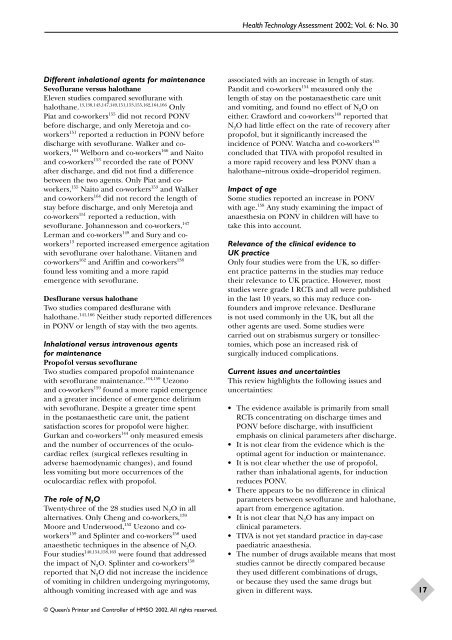Aanesthetic Agents for Day Surgery - NIHR Health Technology ...
Aanesthetic Agents for Day Surgery - NIHR Health Technology ...
Aanesthetic Agents for Day Surgery - NIHR Health Technology ...
You also want an ePaper? Increase the reach of your titles
YUMPU automatically turns print PDFs into web optimized ePapers that Google loves.
Different inhalational agents <strong>for</strong> maintenance<br />
Sevoflurane versus halothane<br />
Eleven studies compared sevoflurane with<br />
halothane. 13,138,143,147,149,151,153,155,162,164,166 Only<br />
Piat and co-workers 155 did not record PONV<br />
be<strong>for</strong>e discharge, and only Meretoja and coworkers<br />
151 reported a reduction in PONV be<strong>for</strong>e<br />
discharge with sevoflurane. Walker and coworkers,<br />
164 Welborn and co-workers 166 and Naito<br />
and co-workers 153 recorded the rate of PONV<br />
after discharge, and did not find a difference<br />
between the two agents. Only Piat and coworkers,<br />
155 Naito and co-workers 153 and Walker<br />
and co-workers 164 did not record the length of<br />
stay be<strong>for</strong>e discharge, and only Meretoja and<br />
co-workers 151 reported a reduction, with<br />
sevoflurane. Johannesson and co-workers, 147<br />
Lerman and co-workers 149 and Sury and coworkers<br />
13 reported increased emergence agitation<br />
with sevoflurane over halothane. Viitanen and<br />
co-workers 162 and Ariffin and co-workers 138<br />
found less vomiting and a more rapid<br />
emergence with sevoflurane.<br />
Desflurane versus halothane<br />
Two studies compared desflurane with<br />
halothane. 141,166 Neither study reported differences<br />
in PONV or length of stay with the two agents.<br />
Inhalational versus intravenous agents<br />
<strong>for</strong> maintenance<br />
Propofol versus sevoflurane<br />
Two studies compared propofol maintenance<br />
with sevoflurane maintenance. 144,159 Uezono<br />
and co-workers 159 found a more rapid emergence<br />
and a greater incidence of emergence delirium<br />
with sevoflurane. Despite a greater time spent<br />
in the postanaesthetic care unit, the patient<br />
satisfaction scores <strong>for</strong> propofol were higher.<br />
Gurkan and co-workers 144 only measured emesis<br />
and the number of occurrences of the oculocardiac<br />
reflex (surgical reflexes resulting in<br />
adverse haemodynamic changes), and found<br />
less vomiting but more occurrences of the<br />
oculocardiac reflex with propofol.<br />
The role of N 2O<br />
Twenty-three of the 28 studies used N 2O in all<br />
alternatives. Only Cheng and co-workers, 139<br />
Moore and Underwood, 152 Uezono and coworkers<br />
159 and Splinter and co-workers 158 used<br />
anaesthetic techniques in the absence of N 2O.<br />
Four studies 140,154,158,163 were found that addressed<br />
the impact of N 2O. Splinter and co-workers 158<br />
reported that N 2O did not increase the incidence<br />
of vomiting in children undergoing myringotomy,<br />
although vomiting increased with age and was<br />
© Queen’s Printer and Controller of HMSO 2002. All rights reserved.<br />
<strong>Health</strong> <strong>Technology</strong> Assessment 2002; Vol. 6: No. 30<br />
associated with an increase in length of stay.<br />
Pandit and co-workers 154 measured only the<br />
length of stay on the postanaesthetic care unit<br />
and vomiting, and found no effect of N 2O on<br />
either. Craw<strong>for</strong>d and co-workers 140 reported that<br />
N 2O had little effect on the rate of recovery after<br />
propofol, but it significantly increased the<br />
incidence of PONV. Watcha and co-workers 163<br />
concluded that TIVA with propofol resulted in<br />
a more rapid recovery and less PONV than a<br />
halothane–nitrous oxide–droperidol regimen.<br />
Impact of age<br />
Some studies reported an increase in PONV<br />
with age. 158 Any study examining the impact of<br />
anaesthesia on PONV in children will have to<br />
take this into account.<br />
Relevance of the clinical evidence to<br />
UK practice<br />
Only four studies were from the UK, so different<br />
practice patterns in the studies may reduce<br />
their relevance to UK practice. However, most<br />
studies were grade I RCTs and all were published<br />
in the last 10 years, so this may reduce confounders<br />
and improve relevance. Desflurane<br />
is not used commonly in the UK, but all the<br />
other agents are used. Some studies were<br />
carried out on strabismus surgery or tonsillectomies,<br />
which pose an increased risk of<br />
surgically induced complications.<br />
Current issues and uncertainties<br />
This review highlights the following issues and<br />
uncertainties:<br />
• The evidence available is primarily from small<br />
RCTs concentrating on discharge times and<br />
PONV be<strong>for</strong>e discharge, with insufficient<br />
emphasis on clinical parameters after discharge.<br />
• It is not clear from the evidence which is the<br />
optimal agent <strong>for</strong> induction or maintenance.<br />
• It is not clear whether the use of propofol,<br />
rather than inhalational agents, <strong>for</strong> induction<br />
reduces PONV.<br />
• There appears to be no difference in clinical<br />
parameters between sevoflurane and halothane,<br />
apart from emergence agitation.<br />
• It is not clear that N 2O has any impact on<br />
clinical parameters.<br />
• TIVA is not yet standard practice in day-case<br />
paediatric anaesthesia.<br />
• The number of drugs available means that most<br />
studies cannot be directly compared because<br />
they used different combinations of drugs,<br />
or because they used the same drugs but<br />
given in different ways.<br />
17
















